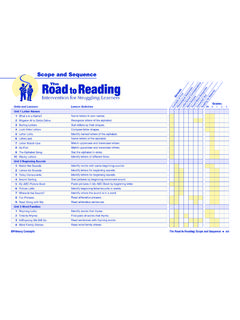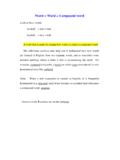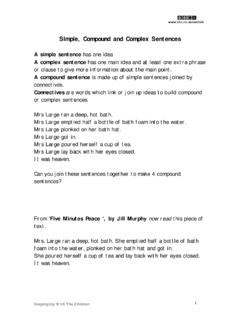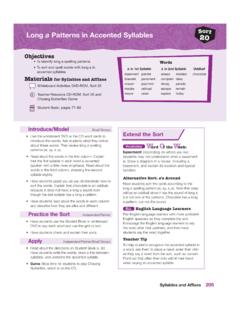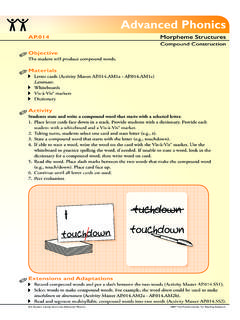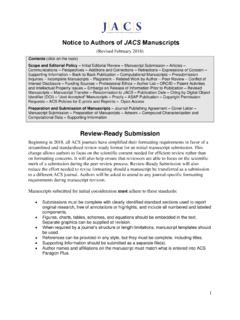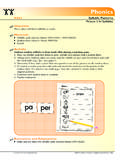Transcription of Lesson Objectives Concepts of Print - The Road to Reading
1 The Road to Reading Primary Concepts 1 Lesson Objectives This list organizes Lesson Objectives by strand. Use the list to plan instruction or correlate program Objectives with your district Objectives , standards, or benchmarks. Concepts of Print Letter Names identify letters in children s own names (Unit 1) identify matching letters of the alphabet (Unit 1) compare the shapes of letters (Unit 1) write letters of the alphabet (Unit 1) identify named letters of the alphabet (Unit 1) name letters of the alphabet (Unit 1) compare uppercase and lowercase letters (Unit 1) match uppercase and lowercase letters (Unit 1) distinguish letters of the alphabet in different fonts (Unit 1) identify letters that are vowels (Unit 4) The Alphabet say the alphabet in order (Unit 1) locate letters arranged in alphabetical order (Unit 2) Tracking Print track Print from left to right, top to bottom, and page to page (Units 1, 2,and 3) hear word boundaries (Unit 1) segment sentences into words (Unit 1)
2 Read a book page to page from front to back (Unit 2) match words to Print (Unit 9) Punctuation and Capitalization identify punctuation marks (period, question mark, exclamation point, comma, quotation marks) (Units 3, 5, and 6) identify capitalized words (names) in text (Unit 5) recognize abbreviations (Unit 6) recognize proper nouns (Unit 6) capitalize beginning words in sentences (Unit 9) understand the role of apostrophes in contractions (Unit 9) understand the role of end punctuation marks in text (Unit 9) Parts of a Book create and use a Table of Contents (Unit 10) The Road to Reading Primary Concepts 2 Phonological Awareness Matching and Comparing Sounds identify words with the same beginning sounds (Units 2 and 6) identify words with the same medial vowel sounds (Units 4, 5, and 7) identify words with the same final sounds (Unit 6) distinguish closely related sounds (Units 2, 5, and 6) distinguish long from short vowel sounds (Units 4 and 7) identify sound differences in similar words (Units 5 and 6) identify sound differences in words with endings s and ed (Unit 11) hear sound differences in word parts (Unit 12) Isolating Sounds isolate beginning sounds in words (Units 2, 4, 5, and 6) isolate medial sounds in words (Units 4, 5, 7, and 8) isolate final sounds in words (Unit 5 and 6) isolate the rime in rhyming words (Unit 3) isolate prefixes and suffixes in spoken words (Unit 12) Segmenting Sounds segment onsets and rimes (Unit 3) segment sounds in words (Units 4, 5, and 6) count sounds in words (Unit 6)
3 Sequencing Sounds identify where a sound is in a word (beginning, middle, or end) (Unit 2) say the sounds in words in order (Unit 5) Rhyming identify words that rhyme (Units 3 and 6) name words that rhyme (Unit 3) Blending blend onsets with rimes (Units 3 and 6) blend sounds to read words (Units 5 and 6) words and Syllables hear word boundaries (Unit 2) segment syllables in words (Unit 10) sort words by number of syllables (Unit 10) blend syllables in words (Unit 10) combine words to create compound words (Unit 10) break down compound words into word parts (Unit 10) orally add endings s, ed, and ing to words (Unit 11) sort words by word ending sounds (Unit 11) The Road to Reading Primary Concepts 3 Letter/Sound Correspondence Consonants name the letter that represents a beginning sound (Unit 2) say the sound represented by a letter (Unit 2) identify a word that begins with a letter/sound (Unit 2) identify beginning letter/sounds in words (Unit 3) name the letter that represents a final sound (Unit 5) identify soft g and c sounds (Unit 7) Vowels connect beginning short vowel sounds with the letters that represent them (Unit 4) connect medial short vowel sounds with the letters that represent them (Unit 4) identify vowels in short vowel CVC words (Unit 4) identify vowel sounds in CVC and CVCe words (Unit 7) name sounds for short and long vowels (Unit 7) match vowel pairs ai, ea, ee, and oa with the sounds they represent (Unit 7) match long and short vowel sounds with the letters or letter patterns that represent them (Unit 7) match vowel pairs oo, ou, and oi with the sounds they represent (Unit 8)
4 Identify consonant and vowel sounds represented by the letter y (Unit 8) match vowel pairs ay and oy with the sounds they represent (Unit 8) match vowel pairs aw, ow, and ew with the sounds they represent (Unit 8) match r-influenced vowels with the sounds they represent (Unit 8) Blends and Digraphs connect blends and digraphs to the sounds they represent (Unit 6) name the letters that represent blends and digraphs (Unit 6) name the sounds represented by blends and digraphs (Unit 6) identify words that begin with letter pairs (Unit 6) Sounding Out words say the sound for each letter in CVC words (Unit 5) place letters in order to spell words (Unit 5) name sounds for letters (Unit 5) match letters with sounds and sounds with letters (Units 5 and 6) match the order of letter/sounds in words (Unit 6) match letters with the sounds they typically represent (Unit 8) identify silent letters in words (Unit 8) Syllables identify letter/sound correspondences in syllables with common patterns (Unit 10) Word Endings identify the letter/sound correspondences for word endings (Unit 11) The Road to Reading Primary Concepts 4 Fluent Word Recognition High Frequency words recognize high frequency words fluently and automatically (Units 2, 3, 5, 6, 7, 9) Phonetically Regular words read CVC words (Unit 5) read words with blends and digraphs (Unit 6) read words with the final e pattern (Unit 7) read words with vowel pairs ai, ea, ee, and oa (Unit 7) read CVC, CVCe, and CVVC words (Unit 7) read phonetically regular words with simple and complex patterns (Unit 8) read phonetically irregular words (Unit 8)
5 Read contractions (Unit 9) Multi-Syllabic words read compound words (Unit 10) read high frequency syllables (Unit 10) read multi-syllabic words syllable by syllable (Unit 10) read words with word endings (Unit 11) read common prefixes and suffixes fluently (Unit 12) read words with prefixes and suffixes (Unit 12) Text Fluency build fluency by Reading and rereading repetitive sentence patterns (Units 3 and 6) use repeated readings to develop fluency Reading text (Unit 8) The Road to Reading Primary Concepts 5 Word Analysis Phonics Patterns identify same letter sequences (rimes) in words (Unit 3) identify words with common rimes (Unit 3) sort CVC words by vowel pattern (Unit 5) identify CVC words (Unit 5) find similarities in words (Unit 5) identify blends and digraphs in words (Unit 6) identify words with final e (CVCe) patterns (Unit 7) identify words with vowel pair (CVVC) patterns (Unit 7) recognize and analyze patterns in words (Units 7, 8, and 9) use word patterns to spell words (Unit 7) identify differences in similarly spelled words (Unit 9) identify ways that words are alike and different (Unit 9) Word Parts identify the two words that make up a contraction (Unit 9) combine words to create compound words (Unit 10) isolate words within compound words (Unit 10) isolate syllables in multi-syllabic words (Unit 10) recognize patterns in syllables (Unit 10) sort multi-syllabic words by pattern (VCCV or VCV) (Unit 10) divide words into syllables (Unit 10) identify root words in words with word endings (Unit 11)
6 Add word endings to root words (double the consonant, drop the e, change y to i, if necessary) (Unit 11) identify patterns in words (_VC, _VCe, _Cy) (Unit 11) identify rules and exceptions to rules for adding word endings (Unit 11) identify prefixes, suffixes, and roots in words (Unit 12) Word Meaning identify the roles of different parts of speech in words (nouns, verbs, adjectives) (Unit 5) identify parts of speech (nouns, verbs, adjectives) (Unit 6) identify homophones (Units 7 and 8) distinguish between plurals and possessives (Unit 11) adjust word endings to form agreement (Unit 11) The Road to Reading Primary Concepts 6 Connected Text Punctuation and Capitalization use punctuation marks in Reading text (Units 5, 6, and 8) use quotation marks in Reading text (Unit 6) use capital letters in Reading text (Unit 8) Genres follow along as text is read (tongue twisters) (Units 1 and 2) read stories (Units 3, 5, and 11) read riddles (Units 4 and 8) write and read rhymes (Unit 6) read jokes (Unit 7) read verses of a song (Unit 9) read nonfiction (Units 10 and 12) Fluent Reading develop fluency in Reading sentences (Unit 9) The Road to Reading Primary Concepts 7 Reading for Meaning Comprehension Strategies retell a sentence in one s own words (Unit 1) visualize the meaning of text (Units 2 and 5) use picture clues to extract meaning (Unit 3) draw pictures to illustrate text (Unit 5) determine whether sentences make sense (Units 5, 6, 7, and 8) interpret text (Unit 6) understand jokes (Unit 7) sequence words to create sentences that make sense (Unit 8)
7 Predict unknown words based on sentence structure and meaning (Unit 8) monitor sense while Reading (Unit 10) choose illustrations to match content of text (Unit 10) fill in the blanks to create sentences that make sense (Unit 12) Vocabulary distinguish real words from nonsense words (Units 3, 4, 6, and 7) name words with similar meanings (synonyms) (Units 4, 7, and 8) identify words that are opposites (antonyms) (Units 8 and 9) understand the meanings of common abbreviations (Unit 6) identify the meanings of homophones (Units 7 and 8) connect words by meaning (Unit 8) identify category words (Unit 8) understand contractions (Unit 9) understand the meaning of compound words (Unit 10) sort words into categories (Unit 10) understand the meaning of words with word endings (Unit 11) identify the meanings of common prefixes and suffixes (Unit 12) use the meanings of prefixes, suffixes, and roots to understand the meanings of words (Unit 12)

